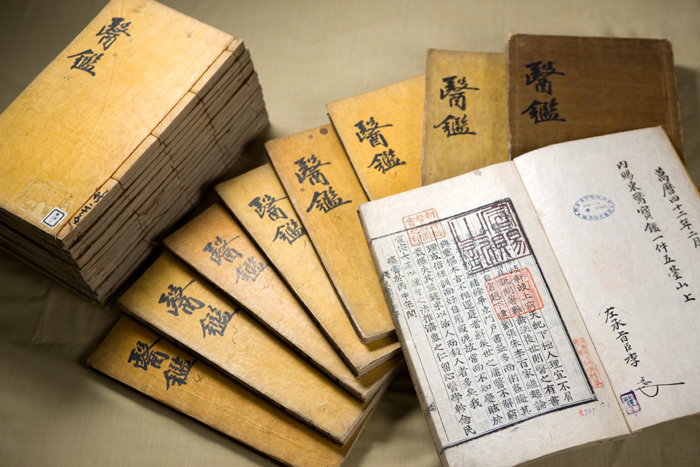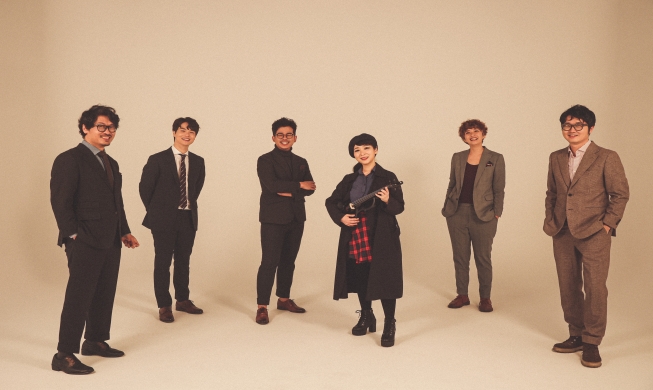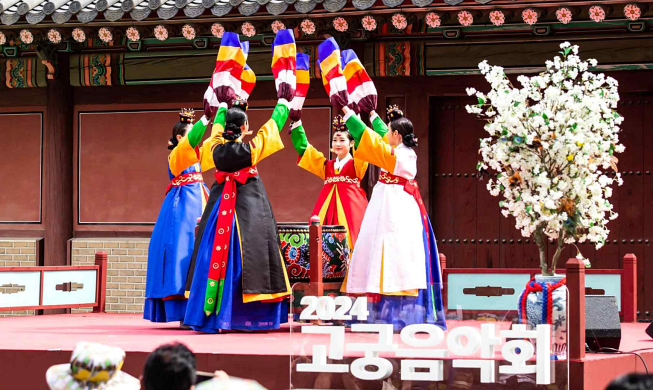-
 Korea.net's 24-hour YouTube channel
Korea.net's 24-hour YouTube channel- NEWS FOCUS
- ABOUT KOREA
- EVENTS
- RESOURCES
- GOVERNMENT
- ABOUT US

The first section on ‘Internal Bodily Elements’ comprises various essays on internal conditions. First, the intrinsic aspects of the body are explained, including the essence 精, qi 氣, spirit 神, and blood 血, followed by dreams, the voice, speech, fluids, and phlegm-rheum, which reflect various aspects of the condition of the body. In the latter part of the section, the visceral organs and bowels are covered extensively. An exposition on metabolism completes the section.

Volume 1: The Body, Essence, Qi, and the Spirit
Volume one deals with subjects pertaining to the relationship between the body and nature, as well as the body itself. The chapter on the Body makes up the introduction, and parts on Essence, Qi and the Spirit comprise the details. The part on the Body gives a discussion of general concepts of life, while the parts on Essence, Qi and the Spirit feature explanations of the basic mechanisms of the body’s physiology.
In the section on the Body, there is a general discussion on the fundamental views on life and the body, including birth and the process of aging. Methods for invigorating the life force through nutritional regimens are also covered in detail. Essence is a vital part of the body. Essence is formed prior to the body’s creation, by nutrients from grains. Essence is absorbed deep into the bones to help form the bone marrow and the brain. It also penetrates the pubic region. If yin and yang are not in harmony, then the essence drains downward. Excess draining of Essence will cause weakening of the body, accompanied by back pain and soreness in the knees. Qi is the foundation of life within the body. It is the gateway of breathing and the source of viscera and bowels. Qi makes possible activities of daily life and is acquired directly from the nutrients in food. The spirit is defined as the brightness of being in humans and is the controlling mechanism of mental activities. In that sense, the spirit holds the uppermost position in a human.
Volume 2: The Blood, Dreams, Voice, Speech, Fluids and Humors, and Phlegm and Fluid Retention
In the second volume of ‘Internal Bodily Elements’, the contents of the blood, dreams, voice, speech, fluids and humors, and phlegm and fluid retention are discussed. They provide the key signs for determining the state of the body's internal conditions. Various bleeding patterns indicate the status of blood; dreams are interpreted; one's voice is analyzed; peculiarities of speech are all considered for diagnosing one's condition. Fluids and humors are interpreted by their external manifestations, and phlegm and fluid retention are non-physiological fluids generated inside the body.
Blood governs the five viscera, removes wastes from the six bowels, and then enters the vessels to circulate throughout the body to connect all of its parts. Blood cooperates with qi, where blood acts as water and qi as wind. Qi leads the way for blood. Thus, blood circulates well when qi moves well, and both will stop circulating together when qi stops moving. Dreaming is a phenomenon that results from the instability of spirit. The spirit is unstable when pathogenic energy invades the body, or when the body is in an unhealthy state.
The voice is not just the sounds that come out of the throat. The voice coming out of the body is closely tied with other organs in the body. The heart manages the voice. The lungs are the gate of the voice, and the kidneys are its source. When the external pathogens of wind, cold, heat, and dampness penetrate the heart and lungs, then the voice is hindered. Weakness from deficient Kidney energy also leads to a weakened voice. Speech is also a signal that would express the overall situation of the body. Indistinctive speech often follows the suffering of a severe illness, as the essential qi escapes from the body. Cursing in a loud voice is often attributed to weakened or disconnected liver and gall bladder energy. The inability to stop laughing comes from excessive heart Fire.
Fluids refers to fluids that nourish the tissues around the skin and flows out when the sweat pores are open. Humors enter deep into the bones and act as a lubricant, ensuring smooth bending and stretching. Phlegm and fluid retention are pathological products derived from bodily fluid circulation. The Dongui Bogam claims that "nine out of ten common disorders are caused by phlegm." That is, phlegm-derived illnesses are numerous. Under normal circumstances, fluids in the body turn into blood or lymph. They may also be excreted, but masses of fluids may remain in the body without going through a normal transformation. These masses are known as phlegm or fluid retention. The Dongui Bogam covers these substances extensively after the part on fluids.
Volume 3: The Five Viscera and Six Bowels [liver, heart, spleen, lungs, kidneys, gall bladder, stomach, small intestine, large intestine, bladder, triple energizers ], uterus, and parasites
Heo Jun established this sub-section to arrange accurate knowledge of the five viscera and six bowels. Before dealing with the five viscera individually, he emphasized the mutual relationship among them. The primary interest lies in the definitions of the viscera and bowels, the connections between them, and how their internal aspects are tied with the external parts of the body. The uterus and parasites were also added to this sub-section, even though they are not part of the viscera and the bowels. Still, since they are essential parts of the body, they were included in the same sub-section. In Taoism, parasites are considered part of the body for their importance.
Each viscus and bowel is paired together. The lungs are paired with the large Intestine. The heart is paired with the small intestine. The liver is paired with the gall bladder. The spleen is paired with the stomach. The kidneys are paired with the bladder. The triple energizers, also known as the “bowel of the central ditch,” is the lone bowel without a mate. However, as it is connected with the path for draining water, it is part of the bladder. The five viscera are located internally, but they are also connected with the seven orifices of the face. The nose is part of the lungs, as the lungs’ energy must be harmonized for one to smell a scent. A disorder of the lungs will result in a shortness of breath and the opening of nostrils. The eyes are part of the liver, and the liver energy must be harmonized to distinguish five colors. The edge of the eyelid turns purple with liver disorders. The tongue is part of the heart, and the heart energy must be harmonized to distinguish the five tastes. The length of the tongue shortens, and malar flush occurs when there is a disorder in the heart. The mouth is part of the spleen, and the spleen energy must be harmonized to properly taste food. With disorders of the spleen, the lips turn yellow. The ears are part of the kidneys, and the kidneys’ energy must be harmonized to hear sounds. With disorders of the kidneys, the malar area and the face turn grayish, and the ears dry up.
The word “uterus” in East Asian medicine pertains not only to the womb, but also extends to the idea of a “gate of life.” The uterus is the source where life is conceived. The conception of life is not an action solely of humans, but another name for heaven and earth’s conception, meaning that life originates from the earth. In this chapter, the Dongui Bogam covers various disorders associated with menstruation and allocates pregnancy to a separate volume of ‘Miscellaneous Disorders’, in the chapter on Gynecology.
The chapter on parasites deals with parasites and the tuberculosis-inducing consumptive worm. Suffering from a parasite accumulation is likely caused by an improper regimen while being hungry. Eating raw fish with alcohol and eating undercooked beef and lamb also give rise to various parasites in the body.
Volume 4: Urine and Feces
The last part of ‘Internal Bodily Elements’ deals with urination and defecation. These two substances are waste materials that yield important information for the analysis of the internal conditions of the body. These two are thus discussed last for this purpose.
Urine is produced as food is digested in the stomach, runs down to the large Intestine via both the influence of and filtering of the lower energizer and then enters the bladder. Urine is stored in the bladder, as it contains the sac for storage. The urine in the bladder is not excreted randomly. Instead, it is only excreted under qi transformation. Food is digested in the stomach and enters the small intestine. Once food matter has entered the small intestine, it is branched out into clear and turbid qi in the lower portion of the small intestine, from which fluid enters the bladder and becomes urine, while waste material goes to the large intestine and becomes stool. Disorders of the large intestine arise when pathogenic energy enters the body.

Volume 1: The Body, Essence, Qi, and the Spirit
Volume one deals with subjects pertaining to the relationship between the body and nature, as well as the body itself. The chapter on the Body makes up the introduction, and parts on Essence, Qi and the Spirit comprise the details. The part on the Body gives a discussion of general concepts of life, while the parts on Essence, Qi and the Spirit feature explanations of the basic mechanisms of the body’s physiology.
In the section on the Body, there is a general discussion on the fundamental views on life and the body, including birth and the process of aging. Methods for invigorating the life force through nutritional regimens are also covered in detail. Essence is a vital part of the body. Essence is formed prior to the body’s creation, by nutrients from grains. Essence is absorbed deep into the bones to help form the bone marrow and the brain. It also penetrates the pubic region. If yin and yang are not in harmony, then the essence drains downward. Excess draining of Essence will cause weakening of the body, accompanied by back pain and soreness in the knees. Qi is the foundation of life within the body. It is the gateway of breathing and the source of viscera and bowels. Qi makes possible activities of daily life and is acquired directly from the nutrients in food. The spirit is defined as the brightness of being in humans and is the controlling mechanism of mental activities. In that sense, the spirit holds the uppermost position in a human.
Volume 2: The Blood, Dreams, Voice, Speech, Fluids and Humors, and Phlegm and Fluid Retention
In the second volume of ‘Internal Bodily Elements’, the contents of the blood, dreams, voice, speech, fluids and humors, and phlegm and fluid retention are discussed. They provide the key signs for determining the state of the body's internal conditions. Various bleeding patterns indicate the status of blood; dreams are interpreted; one's voice is analyzed; peculiarities of speech are all considered for diagnosing one's condition. Fluids and humors are interpreted by their external manifestations, and phlegm and fluid retention are non-physiological fluids generated inside the body.
Blood governs the five viscera, removes wastes from the six bowels, and then enters the vessels to circulate throughout the body to connect all of its parts. Blood cooperates with qi, where blood acts as water and qi as wind. Qi leads the way for blood. Thus, blood circulates well when qi moves well, and both will stop circulating together when qi stops moving. Dreaming is a phenomenon that results from the instability of spirit. The spirit is unstable when pathogenic energy invades the body, or when the body is in an unhealthy state.
The voice is not just the sounds that come out of the throat. The voice coming out of the body is closely tied with other organs in the body. The heart manages the voice. The lungs are the gate of the voice, and the kidneys are its source. When the external pathogens of wind, cold, heat, and dampness penetrate the heart and lungs, then the voice is hindered. Weakness from deficient Kidney energy also leads to a weakened voice. Speech is also a signal that would express the overall situation of the body. Indistinctive speech often follows the suffering of a severe illness, as the essential qi escapes from the body. Cursing in a loud voice is often attributed to weakened or disconnected liver and gall bladder energy. The inability to stop laughing comes from excessive heart Fire.
Fluids refers to fluids that nourish the tissues around the skin and flows out when the sweat pores are open. Humors enter deep into the bones and act as a lubricant, ensuring smooth bending and stretching. Phlegm and fluid retention are pathological products derived from bodily fluid circulation. The Dongui Bogam claims that "nine out of ten common disorders are caused by phlegm." That is, phlegm-derived illnesses are numerous. Under normal circumstances, fluids in the body turn into blood or lymph. They may also be excreted, but masses of fluids may remain in the body without going through a normal transformation. These masses are known as phlegm or fluid retention. The Dongui Bogam covers these substances extensively after the part on fluids.
Volume 3: The Five Viscera and Six Bowels [liver, heart, spleen, lungs, kidneys, gall bladder, stomach, small intestine, large intestine, bladder, triple energizers ], uterus, and parasites
Heo Jun established this sub-section to arrange accurate knowledge of the five viscera and six bowels. Before dealing with the five viscera individually, he emphasized the mutual relationship among them. The primary interest lies in the definitions of the viscera and bowels, the connections between them, and how their internal aspects are tied with the external parts of the body. The uterus and parasites were also added to this sub-section, even though they are not part of the viscera and the bowels. Still, since they are essential parts of the body, they were included in the same sub-section. In Taoism, parasites are considered part of the body for their importance.
Each viscus and bowel is paired together. The lungs are paired with the large Intestine. The heart is paired with the small intestine. The liver is paired with the gall bladder. The spleen is paired with the stomach. The kidneys are paired with the bladder. The triple energizers, also known as the “bowel of the central ditch,” is the lone bowel without a mate. However, as it is connected with the path for draining water, it is part of the bladder. The five viscera are located internally, but they are also connected with the seven orifices of the face. The nose is part of the lungs, as the lungs’ energy must be harmonized for one to smell a scent. A disorder of the lungs will result in a shortness of breath and the opening of nostrils. The eyes are part of the liver, and the liver energy must be harmonized to distinguish five colors. The edge of the eyelid turns purple with liver disorders. The tongue is part of the heart, and the heart energy must be harmonized to distinguish the five tastes. The length of the tongue shortens, and malar flush occurs when there is a disorder in the heart. The mouth is part of the spleen, and the spleen energy must be harmonized to properly taste food. With disorders of the spleen, the lips turn yellow. The ears are part of the kidneys, and the kidneys’ energy must be harmonized to hear sounds. With disorders of the kidneys, the malar area and the face turn grayish, and the ears dry up.
The word “uterus” in East Asian medicine pertains not only to the womb, but also extends to the idea of a “gate of life.” The uterus is the source where life is conceived. The conception of life is not an action solely of humans, but another name for heaven and earth’s conception, meaning that life originates from the earth. In this chapter, the Dongui Bogam covers various disorders associated with menstruation and allocates pregnancy to a separate volume of ‘Miscellaneous Disorders’, in the chapter on Gynecology.
The chapter on parasites deals with parasites and the tuberculosis-inducing consumptive worm. Suffering from a parasite accumulation is likely caused by an improper regimen while being hungry. Eating raw fish with alcohol and eating undercooked beef and lamb also give rise to various parasites in the body.
Volume 4: Urine and Feces
The last part of ‘Internal Bodily Elements’ deals with urination and defecation. These two substances are waste materials that yield important information for the analysis of the internal conditions of the body. These two are thus discussed last for this purpose.
Urine is produced as food is digested in the stomach, runs down to the large Intestine via both the influence of and filtering of the lower energizer and then enters the bladder. Urine is stored in the bladder, as it contains the sac for storage. The urine in the bladder is not excreted randomly. Instead, it is only excreted under qi transformation. Food is digested in the stomach and enters the small intestine. Once food matter has entered the small intestine, it is branched out into clear and turbid qi in the lower portion of the small intestine, from which fluid enters the bladder and becomes urine, while waste material goes to the large intestine and becomes stool. Disorders of the large intestine arise when pathogenic energy enters the body.
Most popular
- Band Second Moon spreads fusion sound on California tour
- 76 national heritage sites to allow free admission from May 15
- First Korean-style 'taxi driver' diner opened in New York
- Africa's appeal on full display at downtown festival in Seoul
- UK univ., KCC in London host Korea Day event in Sheffield













